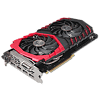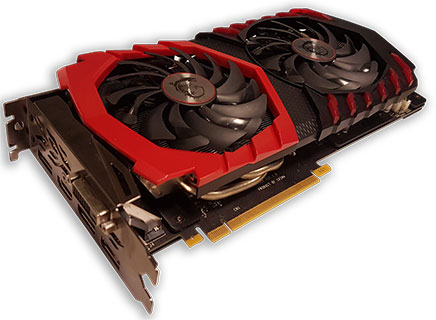 136
136
MSI GeForce GTX 1060 Gaming X 6 GB Review
(136 Comments) »Introduction

With NVIDIA announcing the GeForce GTX 1060, the company is allowing its add-in card (AIC) partners to launch their custom-design cards right away. The company set the MSRP of this SKU at US $249 and is selling its reference-design "Founders Edition" SKU at $299, a $50 premium. This allows its partners to launch their custom-design cards at either around the $249 baseline price or the $299 Founders Edition one.
The GeForce GTX 1060 is NVIDIA's response to the Radeon RX 480, which offers performance rivaling that of $350 products from the previous-generation, at an attractive $229 price-point. It is based on the newer 16 nm GP106 silicon, which is the third ASIC built on the "Pascal" architecture. This chip features half the SIMD machinery of the GP104 silicon on which the GTX 1080 is based, but has 75% of the raster operation machinery and memory configuration.

MSI Gaming is one of the most popular graphics card brands these days, and the company's GeForce GTX 1060 Gaming X graphics card we're reviewing today is priced at $289, a $40 premium over the baseline MSRP and $10 cheaper than the Founders Edition. What you get is a custom-design PCB with a stronger VRM, which draws power from an 8-pin PCIe power connector, and the iconic Twin Frozr VI cooling solution, which is also featured on the company's GTX 1070 and GTX 1080 Gaming X products.
The GeForce GTX 1060 features 1,280 CUDA cores, 80 TMUs, 48 ROPs, and a 192-bit GDDR5 memory interface with 6 GB of memory. The MSI GeForce GTX 1060 Gaming X ships with factory-overclocked speeds of 1569 MHz on the core and an untouched 8 Gbps memory for 192 GB/s of memory bandwidth. You get quite a bit of the feature-set NVIDIA introduced with the "Pascal" architecture, but the biggest omission is support for NVIDIA SLI. The company clearly doesn't want a pair of GTX 1060 cards to outsell one GTX 1080, and it looks as though you won't find SLI on even custom-design cards.
| GeForce GTX 960 | Radeon R9 380X | Radeon R9 390 | GeForce GTX 970 | Radeon RX 480 | Radeon R9 390X | GeForce GTX 780 Ti | GeForce GTX 980 | GeForce GTX 1060 | MSI GTX 1060 Gaming X | Radeon R9 Fury | Radeon R9 Fury X | GeForce GTX 980 Ti | GeForce GTX Titan X | GeForce GTX 1070 | |
|---|---|---|---|---|---|---|---|---|---|---|---|---|---|---|---|
| Shader Units | 1024 | 2048 | 2560 | 1664 | 2304 | 2816 | 2880 | 2048 | 1280 | 1280 | 3584 | 4096 | 2816 | 3072 | 1920 |
| ROPs | 32 | 32 | 64 | 56 | 32 | 64 | 48 | 64 | 48 | 48 | 64 | 64 | 96 | 96 | 64 |
| Graphics Processor | GM206 | Tonga | Hawaii | GM204 | Ellesmere | Hawaii | GK110 | GM204 | GP106 | GP106 | Fiji | Fiji | GM200 | GM200 | GP104 |
| Transistors | 2940M | unknown | 6200M | 5200M | 5700M | 6200M | 7100M | 5200M | 4400M | 4400M | 8900M | 8900M | 8000M | 8000M | 7200M |
| Memory Size | 2 GB | 4 GB | 8 GB | 4 GB | 4 GB / 8 GB | 8 GB | 3 GB | 4 GB | 6 GB | 6 GB | 4 GB | 4 GB | 6 GB | 12 GB | 8 GB |
| Memory Bus Width | 128 bit | 256 bit | 512 bit | 256 bit | 256 bit | 512 bit | 384 bit | 256 bit | 192 bit | 192 bit | 4096 bit | 4096 bit | 384 bit | 384 bit | 256 bit |
| Core Clock | 1127 MHz+ | 970 MHz | 1000 MHz | 1051 MHz+ | 1120 - 1266 MHz | 1050 MHz | 876 MHz+ | 1126 MHz+ | 1506 MHz+ | 1569 MHz+ | 1000 MHz | 1050 MHz | 1000 MHz+ | 1000 MHz+ | 1506 MHz+ |
| Memory Clock | 1753 MHz | 1425 MHz | 1500 MHz | 1750 MHz | 2000 MHz | 1500 MHz | 1750 MHz | 1750 MHz | 2002 MHz | 2002 MHz | 500 MHz | 500 MHz | 1750 MHz | 1750 MHz | 2002 MHz |
| Price | $170 | $210 | $260 | $265 | $199 / $229 | $310 | $390 | $360 | $249 / $299 | $289 | $530 | $600 | $440 | $1150 | $379 / $449 |
Packaging
You will receive:
- Graphics card
- Driver CD + documentation
- MSI stickers
The Card
We've seen MSI's new TwinFrozr thermal solution on the company's GTX 1070 and 1080, and it looks great due to MSI's attention to little details; it is made of plastic, though, which is unlike the NVIDIA Founders Edition. On the back is a high-quality metal backplate. Dimensions of the card are 28x14 cm.
Installation requires two slots in your system.
Display connectivity options include a DVI port, an HDMI port, and three DisplayPorts. Unlike previous NVIDIA cards, the DVI port no longer includes an analog signal, so you'll have to use an active adapter. NVIDIA also updated DisplayPort to be 1.2 certified and 1.3/1.4 ready, which enables support for 4K @ 120 Hz and 5K @ 60 Hz or 8K @ 60 Hz with two cables.
The GPU also comes with an HDMI sound device. It is HDMI 2.0b compatible, which supports HD audio and Blu-ray 3D movies. The GPU video encoding unit has been updated to support HEVC at 10-bit and 12-bit.
The GeForce GTX 1060 does not support SLI.
Pictured above are the front and back, showing the disassembled board. High-res versions are also available (front, back).
A Closer Look
MSI's cooler uses three heatpipes to keep the card cool.
Once the main heatsink is removed, you can see a second metal plate, which provides cooling for the VRM circuitry and memory chips.
The backplate is made from metal and protects the card against damage during handling and installation.
MSI replaced the single 6-pin power input of the reference design with an 8-pin power connector. This configuration is specified for up to 225 watts of power draw.
NVIDIA's GTX 1060 is introducing a new voltage controller by uPI, the uP 9509P. Its exact feature set is currently unknown.
The GDDR5 memory chips are made by Samsung and carry the model number K4G80325FB-HC25. They are specified to run at 2000 MHz (8000 MHz GDDR5 effective).
NVIDIA's GP106 graphics processor is the second consumer chip using the Pascal architecture. It is produced on a 16 nm process at TSMC, Taiwan, with a transistor count of 4.4 billion and a die size of 200 mm².
Our Patreon Silver Supporters can read articles in single-page format.
Jul 28th, 2025 20:56 CDT
change timezone
Latest GPU Drivers
New Forum Posts
- Warning about DOCP (29)
- need 2tb + SATA SSD ASAP!!! needs to be reliable and not entry level crap (4)
- Mouse and CPU usage. (2)
- What antivirus do you use? (37)
- Upgrade from old x58 system (48)
- Kindly help me to complete my new PC build... (19)
- Which Linux flavor? (77)
- What's your latest tech purchase? (24383)
- What phone you use as your daily driver? And, a discussion of them. (1819)
- Inno3D iChiLL (1)
Popular Reviews
- Herman Miller Logitech G Embody Review - No Pain, No Gain
- Lian Li O11 Dynamic Mini V2 Review
- Upcoming Hardware Launches 2025 (Updated May 2025)
- Noctua NF-A12x25 G2 PWM Fan Review
- VAXEE XE V2 Wireless Review
- AQIRYS Sirius Pro Review
- Sapphire Radeon RX 9060 XT Pulse OC 16 GB Review - An Excellent Choice
- AMD Ryzen 7 9800X3D Review - The Best Gaming Processor
- UPERFECT UMax 24 Review
- NVIDIA GeForce RTX 5050 8 GB Review
TPU on YouTube
Controversial News Posts
- AMD's Upcoming UDNA / RDNA 5 GPU Could Feature 96 CUs and 384-bit Memory Bus (134)
- AMD Radeon RX 9070 XT Gains 9% Performance at 1440p with Latest Driver, Beats RTX 5070 Ti (131)
- NVIDIA GeForce RTX 5080 SUPER Could Feature 24 GB Memory, Increased Power Limits (115)
- Intel "Nova Lake-S" Core Ultra 3, Ultra 5, Ultra 7, and Ultra 9 Core Configurations Surface (109)
- NVIDIA DLSS Transformer Cuts VRAM Usage by 20% (100)
- DDR6 Memory Arrives in 2027 with 8,800-17,600 MT/s Speeds (99)
- AMD Sampling Next-Gen Ryzen Desktop "Medusa Ridge," Sees Incremental IPC Upgrade, New cIOD (97)
- Intel CEO Confirms SMT To Return to Future CPUs (95)



















